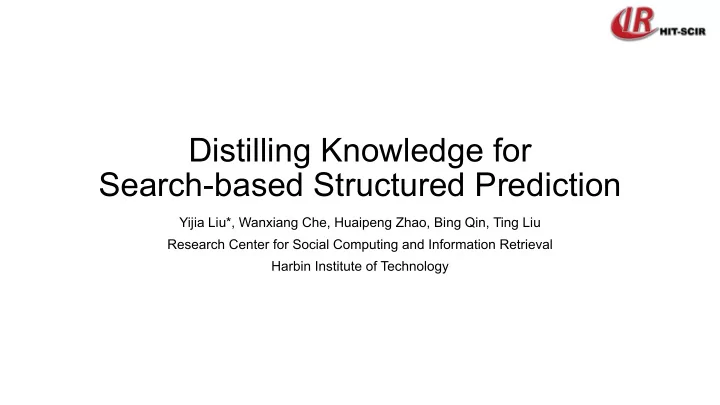

Distilling Knowledge for Search-based Structured Prediction Yijia Liu*, Wanxiang Che, Huaipeng Zhao, Bing Qin, Ting Liu Research Center for Social Computing and Information Retrieval Harbin Institute of Technology
Complex Model Wins [ResNet, 2015] [He+, 2017]
93 26.5 92.5 25 92 91.5 23.5 91 22 90.5 90 20.5 Dependency Parsing NMT Baseline search SOTA Distillation Ensemble Baseline search SOTA Distillation Ensemble
93 26.5 92.5 0.8 0.6 25 92 2.6 1.3 91.5 23.5 91 22 90.5 90 20.5 Dependency Parsing NMT Baseline search SOTA Distillation Ensemble Baseline search SOTA Distillation Ensemble
Classification vs. Structured Prediction ! " Classifier Structured ! " # , " % , … , y ( Predictor
Classification vs. Structured Prediction I like this book Classifier Structured I like this book ��������� Predictor
Search-based Structured Prediction I like this book ��������� Search Space
! " # that Controls Search Process p(y | I, like ) 1 0.5 0 book i like love the this I like this book ��������� Search Space
Generic ! " # Learning Algorithm $ (y= this ) argmax p(y | I, like ) 1 0.5 0 book I like love the this I like this book ��������� Search Space
Problems of the Generic Learning Algorithm Ambiguities in training data “both this and the seems reasonable” I like this book ��������� the Search Space
Problems of the Generic Learning Algorithm Ambiguities in training data Training and test discrepancy “both this and the seems reasonable” “What if I made wrong decision?” I like this book ��������� love the ? Search Space
Solutions in Previous Works Ambiguities in training data Training and test discrepancy Ensemble (Dietterich, 2000) Explore (Ross and Bagnell, 2010) I like this book ��������� love the Search Space
Where We Are Knowledge Distillation Ambiguities in training data Training and test discrepancy I like this book ��������� love the Search Space
Knowledge Distillation Learning from negative log-likelihood Learning from knowledge distillation ! (y= this ) argmax p(y | I, like ) argmax sum y q(y) p(y | I, like ) 1 1 0.5 0.5 0 0 book I like love the this book I like love the this " # $, &'()) is the output distribution of a teacher model (e.g. ensemble) On supervised data argmax 0 ! (y= this ) p(y | I, like ) sum y q(y) p(y | I, like ) 1 1 1 − 3 + 3 0.5 0.5 0 0 book I like love the this book I like love the this
Knowledge Distillation: from Where Learning from knowledge distillation argmax sum y q(y) p(y | I, like ) 1 0.5 0 book I like love the this Ambiguities in training data Ensemble (Dietterich, 2000) We use ensemble of M structure predictor as the teacher q
KD on Supervised (reference) Data ! (y=this) p(y | I, like ) sum y q(y) p(y | I, like ) 1 1 1 − $ + $ ! (y=this) 0.5 0.5 0 0 book I like love the this book I like love the this I like this book ��������� the Search Space
KD on Explored Data sum y q(y) p(y | I, like, the ) 1 0.5 0 book I like love the this I like book ��������� this the Training and test discrepancy Search Space Explore (Ross and Bagnell, 2010) We use teacher q to explore the search space & learn from KD on the explored data
We combine KD on reference and explored data
Experiments Transition-based Dependency Parsing LAS Neural Machine Translation BLEU Penn Treebank (Stanford dependencies) IWSLT 2014 de-en Baseline 22.79 Baseline 90.83 Ensemble (20) 92.73 Ensemble (10) 26.26 Distill (reference, ! = 1.0 ) Distill (reference, ! = 0.8 ) 91.99 24.76 Distill (exploration) 92.00 Distill (exploration) 24.64 Distill (both) 92.14 Distill (both) 25.44 MIXER (Ranzato et al. 2015) 20.73 Ballesteros et al. (2016) (dyn. oracle) 91.42 Andor et al. (2016) (local, B=1) 91.02 Wiseman and Rush (2016) (local B=1) 22.53 Wiseman and Rush (2016) (global B=1) 23.83
Analysis: Why the Ensemble Works Better? • Examining the ensemble on the “ problematic ” states. Optimal-yet-ambiguous Non-optimal I like this book ��������� love the
Analysis: Why the Ensemble Works Better? • Examining the ensemble on the “ problematic ” states. • Testbed: Transition-based dependency parsing . • Tools: dynamic oracle , which returns a set of reference actions for one state. • Evaluate the output distributions against the reference actions. optimal-yet-ambiguous non-optimal Baseline 68.59 89.59 Ensemble 74.19 90.90
Analysis: Is it Feasible to Fully Learn from KD w/o NLL? 27.13 92.07 27.04 92.04 26.96 26.95 91.93 91.9 26.64 26.6 91.72 91.7 26.37 26.21 91.55 26.09 91.49 25.9 91.3 91.1 24.93 90.9 0 0.1 0.2 0.3 0.4 0.5 0.6 0.7 0.8 0.9 1 0 0.1 0.2 0.3 0.4 0.5 0.6 0.7 0.8 0.9 1 Transition-based Parsing Neural Machine Translation Fully learning from KD is feasible
Analysis: Is Learning from KD Stable? Transition-based Parsing Neural Machine Translation
Conclusion • We propose to distill an ensemble into a single model both from reference and exploration states. • Experiments on transition-based dependency parsing and machine translation show that our distillation method significantly improves the single model’s performance. • Analysis gives empirically guarantee for our distillation method.
Thanks and Q/A
Recommend
More recommend